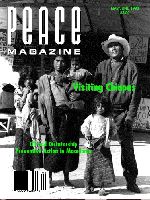
Peace Magazine May-June 1998, page 30. Some rights reserved.
Search for other articles by Joanna Santa Barbara here
Judith Large, Hawthorn Press, 1997. $35.00
Judith Large set out to determine "whether there are ways in which outsiders can intervene early enough and in any meaningful way to assist and strengthen local capacity for violence reduction" in the Balkan wars. The "outsiders" of interest were the hundreds of non-governmental, non-military agencies (there were several U.K. and U.S. private military organizations involved) who sought to help in various ways. These are the "second-track" interveners, alongside the "first-track" interveners - governments and inter-governmental organizations.
She addressed such questions as: Did ideas from outside assist a group in becoming more effective? Was "help" ever actual interference? Did it lead to the creation of new elites? How do we measure effectiveness? Is it possible to speak of a relationship between individual change and social change in wartime? Are there entry points from which to change culture and structures of militarism?
Large's methods included 200 interviews over four years of intervention-recipients and field workers and the examination of a great deal of formal and informal documentation. She tries to apply an analytic framework to this complex arena, some of it quite helpful, such as categorizing second-track intervention as aid, advocacy, communications, education and training, facili- tation, mediation and negotiation, reconstruction, therapeutic work, and witness.
This work is an antidote for the naiveté of assuming that anything well-intended will be helpful and that concepts that give us a warm glow are bound to be useful. There are entire chapters of critique of the concepts of "conflict resolution" and of "civil society." The problems of humanitarian aid are sharply criticized. To my mind these were a little unbalanced toward the negative.
Some interesting conclusions emerged:
Support of independent media, telephone, and e-mail communication and face-to-face meetings have high impact.
Long term commitment by outsiders is important. "Project" frameworks can distort intervention.
Interveners should support indigenous leadership and activity rather than importing packaged solutions. A community development framework is recommended.
Large considered the case of Eastern Slavonia, a portion of Croatia occupied and ethnically cleansed by Serbian forces in 1991. In 1995, an agreement was reached for the area to revert to Croatian control. Thousands of refugees were to return. U.N. military and civilian personnel assisted the return. Large believes a broad range of second-track interventions supported the relatively nonviolent population movement in this volatile region: work with children and teachers in schools to promote cooperation and prejudice reduction; small-scale livelihood projects; dialogue round-tables and public meetings to counter nationalist ideology; action on minority rights; housing law; legal advice; nonviolent dispute resolution; solidarity, support and witness of international volunteers accompanying individuals to court, communicating to the outside world, and driving people across borders.
This study is a useful contribution to the early development of our understanding of what works in limiting war.
Reviewed by Joanna Santa Barbara, a Hamilton psychiatrist and peace educator.

Peace Magazine May-June 1998, page 30. Some rights reserved.
Search for other articles by Joanna Santa Barbara here